Unit 2 Great People Lesson 12 Guess My Hero! 课件(共27张PPT)
文档属性
| 名称 | Unit 2 Great People Lesson 12 Guess My Hero! 课件(共27张PPT) | 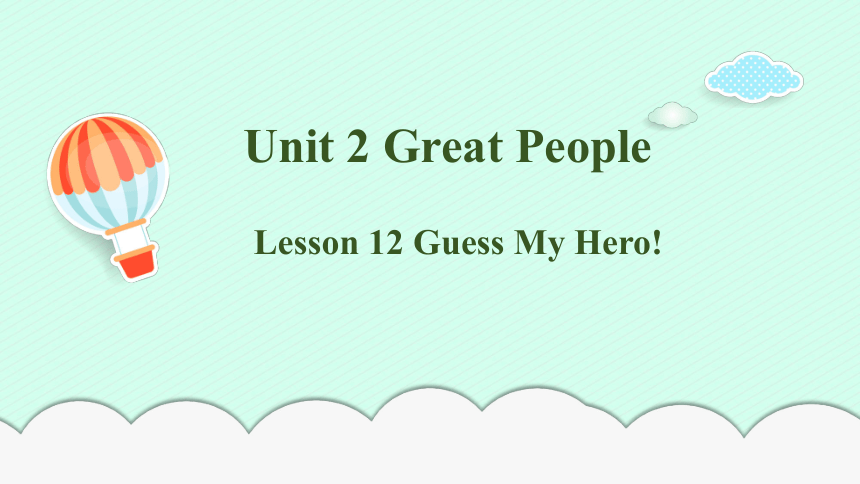 | |
| 格式 | zip | ||
| 文件大小 | 20.7MB | ||
| 资源类型 | 教案 | ||
| 版本资源 | 冀教版 | ||
| 科目 | 英语 | ||
| 更新时间 | 2021-09-19 11:33:29 | ||
图片预览


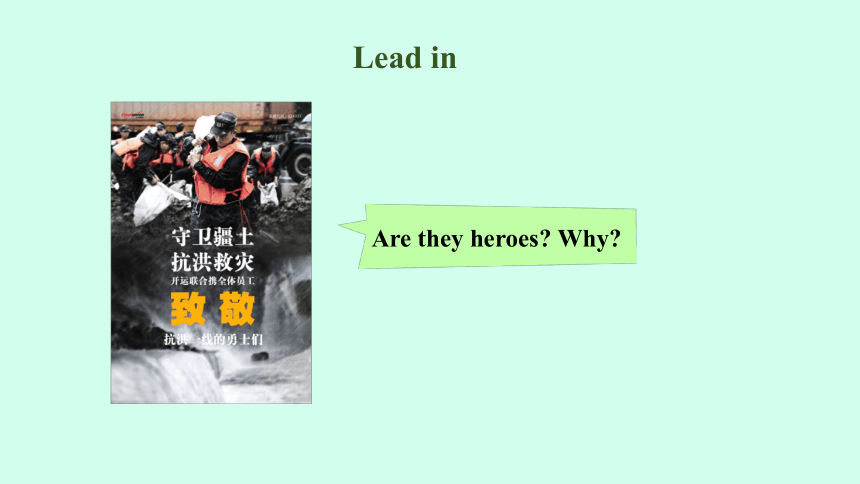
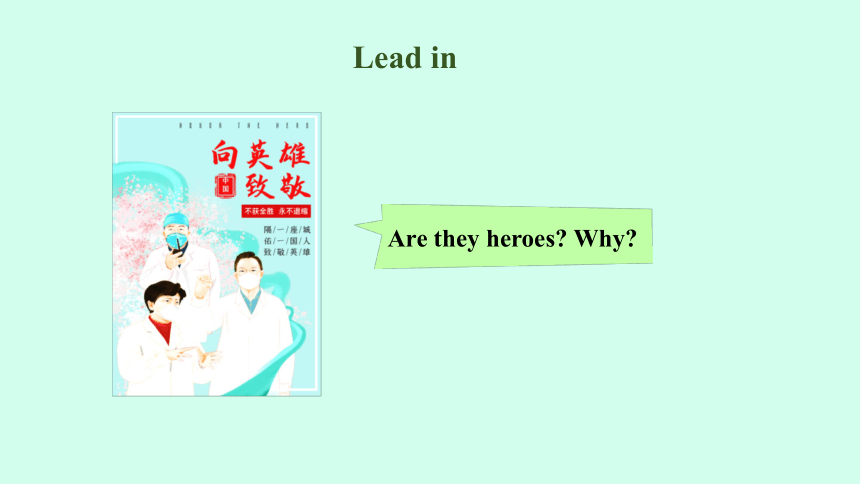


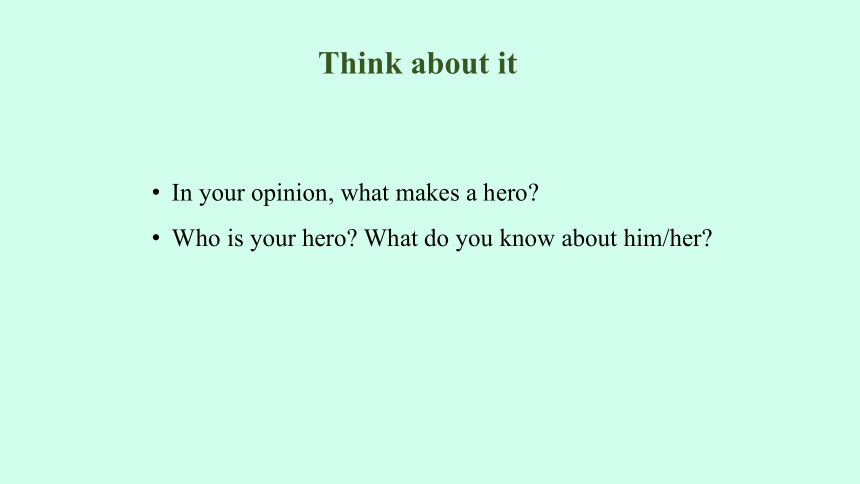
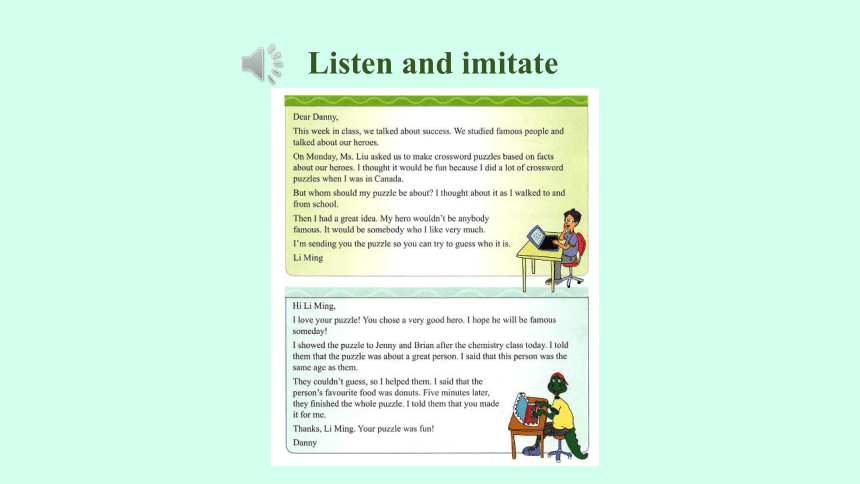
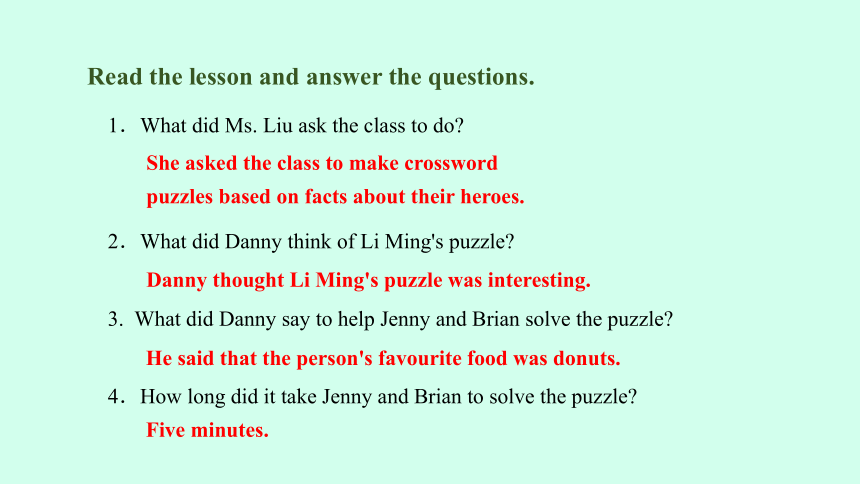
文档简介
(共27张PPT)
Unit
2
Great
People
Lesson
12
Guess
My
Hero!
We
will
learn
The
new
words:
crossword,
puzzle,
based,
whom,
anybody,
chemistry
Important
and
difficult
points:
1)
I
thought
about
it
as
I
walked
to
and
from
school.
2)
It
would
be
somebody
who
I
like
very
much.
3)
I
said
that
this
person
was
the
same
age
as
them.
4)
I
told
them
that
you
made
it
for
me.
Lead
in
Are
they
heroes?
Why?
Are
they
heroes?
Why?
Lead
in
Is
he
a
hero?
Why?
Lead
in
Do
you
have
a
hero
in
your
class?
Lead
in
Think
about
it
In
your
opinion,
what
makes
a
hero?
Who
is
your
hero?
What
do
you
know
about
him/her?
Listen
and
imitate
Read
the
lesson
and
answer
the
questions.
1.What
did
Ms.
Liu
ask
the
class
to
do?
2.What
did
Danny
think
of
Li
Ming's
puzzle?
3.
What
did
Danny
say
to
help
Jenny
and
Brian
solve
the
puzzle?
4.How
long
did
it
take
Jenny
and
Brian
to
solve
the
puzzle?
She
asked
the
class
to
make
crossword
puzzles
based
on
facts
about
their
heroes.
Danny
thought
Li
Ming's
puzzle
was
interesting.
He
said
that
the
person's
favourite
food
was
donuts.
Five
minutes.
1.based
on
以……为基础;基于
e.g.
This
novel
is
based
on
historical
facts.
这部小说是以历史事实为根据的。
base
sth.
on
sth.“以……为根据”。
e.g.
You
should
base
your
opinion
on
facts.
你的意见应该以事实为根据。
be
based
on
“以……为根据”,常用于A
be
based
on
B。
e.g.
The
story
is
based
on
real
life.
这个故事是以现实生活为根据的。
Language
points
Language
points
2.
I
thought
about
it
as
I
walked
to
and
from
school.
当我上学和放学时我都在考虑它。
when,
while,
as
都可引导时间状语从句。这几个词都可以表示“当……时候”,当它们引导的从句的谓语动词是延续性的,三个词可以互换。
when的用法最广,既可以表示比从句早或晚的动作,也可以表示与从句同时进行的动作,可以指时间点,也可以指时间段;并且它可以与短暂性动词连用。
as
表示与主句同时进行的动作,指时间点时可以与when互换。
while
只指时间段,引导延续性动作;如表示与主句动作同时进行时,可与when,
as
互换。
Language
points
e.g.
①When
(As,
While)
he
talked
on,
he
got
more
and
more
excited.
他越谈越激动。
(这句话中的主句和从句动词动作同时进行,表示时间段)
②He
hurried
home,
looking
behind
as
he
went.
他赶紧回家,一边走一边往后看。
(主句和从句动作平行,表示时间段)
③While
the
child
was
playing
with
his
toys,
his
parents
were
reading.
孩子在玩玩具,他的父母在看书。
(表示时间段,主句和从句都是同时进行的表示延续的动作)
3.the
same...as
与……一样
e.g.
She
wants
to
buy
the
same
blouse
as
I
have.
她想买跟我的一样的衬衫。
the
same
as可以用:the
same+名词+as;
也可以什么都不加,直接用the
same
as。
e.g.
She
is
the
same
age
as
you.她和你年龄相同。
Your
answer
is
the
same
as
his.你的答案和他的一样。
be
the
same
as的反义词组为:be
different
from
“与……不同”。
e.g.
My
way
of
life
is
different
from
hers.
我的生活方式和她的不同。
Language
points
4.five
minutes
later
五分钟以后
“一段时间+later”表示“一段时间以后”,是一个固定搭配。
e.g.
Two
hours
later,he
finished
the
work.
两个小时后,他完成了这项工作。
Language
points
later,in与after的辨析
知识拓展
later“……之后”,用于过去时或将来时,可与时间段连用,也可单独使用。
e.g.
Two
months
later,I'll
return
to
Beijing.两个月后,我将返回北京。
in“在……之后”,后接一段时间,常用于将来时中。
e.g.
It
will
be
ready
in
a
week's
time.只需一周的时间就会准备好。
after“在……之后”,既可用于将来时中,也可用于过去时中,后可跟一个时间点,也可跟一个时间段。
e.g.
We
will
get
there
after
two
o'clock.两点钟后我们将到达那里。
Language
points
5.
I
told
them
that
you
made
it
for
me.
我告诉他们这是你给我做的。
某些及物动词后面可以加两个宾语,一个表示人,叫间接宾语;一个表示物,叫直接宾语,它们和在一起称作双宾语。双宾语在句子的位置有两种:
主语
+
及物动词
+
间接宾语
+
直接宾语
主语
+
及物动词
+
直接宾语
+
介词
to
或
for
+
间接宾语
Language
points
如果把间接宾语放在直接宾语之后,间接宾语前就应该加介词to或for。这里加to
或for与动词有关,能够加to的动词有:give,
show,
send,
bring,
read,
pass,
lend,
leave,
hand,
tell,
return,
write,
throw,
promise,
refuse,
sell,
take,
teach,
call,
wish等。能够加for的动词有:make,
buy,
do,
get,
play,
order,
sing,
dance,
cook,
pay,
build,
fill,
find,
prepare,
save,
win等。
e.g.
①He
will
make
me
a
new
kite.
=
He
will
make
a
new
kite
for
me.
他要给我做一个新风筝。
②Grandpa
often
tells
us
stories.
=
Grandpa
often
tells
stories
to
us.
爷爷经常给我们讲故事。
2)Fill
in
the
blanks
with
the
words
in
the
box.
1.A:
For
________
is
this
book
written?
B:
It's
written
for
young
kids.
2.The
___________
is
making
great
efforts
to
help
people
live
better.
3.I
don't
want
to
be
________
else.
I
just
want
to
be
myself.
4.Many
________
teams
entered
Wenchuan
after
the
earthquake.
5.In
___________
experiments,
interesting
things
can
happen.
whom
government
anybody
whom anybody chemistry government medical
Let’s
Do
It
!
medical
chemistry
PROJECT
Write
a
short
paragraph
about
your
hero.
Then
use
words
from
your
paragraph
to
make
a
crossword
puzzle.
Give
your
paragraph
and
crossword
puzzle
to
a
friend.
Can
your
friend
solve
your
puzzle?
Here
is
Li
Ming's
puzzle
as
an
example.
WHO'S
YOUR
HERO?
Let’s
Do
It
!
ACROSS
1.
This
is
his
favourite
food.
(It's
sweet
and
round.)
3.
His
skin
is
this
colour.
5.
He
likes
this
sweet
drink.
6.
I
laugh
because
he's
________.
7.
Since
he's
tall,
he's
good
at
this
game.
donut
brown
funny
basketball
Let’s
Do
It
!
DOWN
He's
this
kind
of
animal.
2.
He's
not
short.
He's
________.
4.
He
comes
from
this
country.
He
also
likes
this
food.(It's
round
and
delicious!)
tall
dinosaur
Canada
pizza
Let’s
Do
It
!
一、用适当的介词填空。
1.
Australia
is
famous
_______
its
sheep
and
kangaroos.
2.
Tony
and
I
talked
_______
success
this
morning
and
we
decided
to
work
hard
from
now
on.
3.
Please
show
your
new
watch
_______
me.
4.
We
are
proud
_______
her.
5.
My
friend
was
born
_______
the
morning
of
I
June,
1994.
Exercises
for
about
to
of
on
二、单项选择
1.
Confucius
was
a
famous
philosopher
(哲学家)
__________
has
influenced
the
world
greatly.
A.
whose
B.
whom
C.
which
D.
who
2.
—Why
are
you
so
late?
—__________
my
bike
was
broken.
A.
As
B.
For
C.
Because
D.
Since
3.
Our
teachers
always
give
us
good
advice.
We
should
follow
__________.
A.
what
do
they
say
B.
what
they
say
C.
which
they
say
D.
which
they
say
Exercises
D
C
B
三、根据汉语完成句子
1.
格林老师被认为是学校最好的老师。
Mr.
Green
__________
__________
to
be
the
best
teacher
in
the
school.
2.
热可以与光一样以相同的方式传播。
Heat
may
travel
in
__________
__________
manner
__________
light
does.
3.
《纽约世界报》发布了第一个现代纵横字谜游戏。
The
New
York
World
published
the
first
modern
__________
__________.
4.
李松告诉刘老师他想帮她教英语。
Li
Song
told
Miss
Liu
that
he
__________
__________
to
help
her
teach
English.
5.
这个故事以一个真实女孩的亲身经历为依据。
The
story
is
__________
__________
a
real
girl’s
experiences.
Exercises
is
thought
the
same
as
crossword
puzzle
would
like
based
on
Summary
Phrases:
based
on,
the
same
as…,
five
minutes
later
Sentences:
1)
I
thought
about
it
as
I
walked
to
and
from
school.
2)
It
would
be
somebody
who
I
like
very
much.
3)
I
said
that
this
person
was
the
same
age
as
them.
4)
I
told
them
that
you
made
it
for
me.
Homework
1.Write
a
passage
about
your
hero.
2.Preview
Unit
3-Lesson
13.
Bye-bye!
Unit
2
Great
People
Lesson
12
Guess
My
Hero!
We
will
learn
The
new
words:
crossword,
puzzle,
based,
whom,
anybody,
chemistry
Important
and
difficult
points:
1)
I
thought
about
it
as
I
walked
to
and
from
school.
2)
It
would
be
somebody
who
I
like
very
much.
3)
I
said
that
this
person
was
the
same
age
as
them.
4)
I
told
them
that
you
made
it
for
me.
Lead
in
Are
they
heroes?
Why?
Are
they
heroes?
Why?
Lead
in
Is
he
a
hero?
Why?
Lead
in
Do
you
have
a
hero
in
your
class?
Lead
in
Think
about
it
In
your
opinion,
what
makes
a
hero?
Who
is
your
hero?
What
do
you
know
about
him/her?
Listen
and
imitate
Read
the
lesson
and
answer
the
questions.
1.What
did
Ms.
Liu
ask
the
class
to
do?
2.What
did
Danny
think
of
Li
Ming's
puzzle?
3.
What
did
Danny
say
to
help
Jenny
and
Brian
solve
the
puzzle?
4.How
long
did
it
take
Jenny
and
Brian
to
solve
the
puzzle?
She
asked
the
class
to
make
crossword
puzzles
based
on
facts
about
their
heroes.
Danny
thought
Li
Ming's
puzzle
was
interesting.
He
said
that
the
person's
favourite
food
was
donuts.
Five
minutes.
1.based
on
以……为基础;基于
e.g.
This
novel
is
based
on
historical
facts.
这部小说是以历史事实为根据的。
base
sth.
on
sth.“以……为根据”。
e.g.
You
should
base
your
opinion
on
facts.
你的意见应该以事实为根据。
be
based
on
“以……为根据”,常用于A
be
based
on
B。
e.g.
The
story
is
based
on
real
life.
这个故事是以现实生活为根据的。
Language
points
Language
points
2.
I
thought
about
it
as
I
walked
to
and
from
school.
当我上学和放学时我都在考虑它。
when,
while,
as
都可引导时间状语从句。这几个词都可以表示“当……时候”,当它们引导的从句的谓语动词是延续性的,三个词可以互换。
when的用法最广,既可以表示比从句早或晚的动作,也可以表示与从句同时进行的动作,可以指时间点,也可以指时间段;并且它可以与短暂性动词连用。
as
表示与主句同时进行的动作,指时间点时可以与when互换。
while
只指时间段,引导延续性动作;如表示与主句动作同时进行时,可与when,
as
互换。
Language
points
e.g.
①When
(As,
While)
he
talked
on,
he
got
more
and
more
excited.
他越谈越激动。
(这句话中的主句和从句动词动作同时进行,表示时间段)
②He
hurried
home,
looking
behind
as
he
went.
他赶紧回家,一边走一边往后看。
(主句和从句动作平行,表示时间段)
③While
the
child
was
playing
with
his
toys,
his
parents
were
reading.
孩子在玩玩具,他的父母在看书。
(表示时间段,主句和从句都是同时进行的表示延续的动作)
3.the
same...as
与……一样
e.g.
She
wants
to
buy
the
same
blouse
as
I
have.
她想买跟我的一样的衬衫。
the
same
as可以用:the
same+名词+as;
也可以什么都不加,直接用the
same
as。
e.g.
She
is
the
same
age
as
you.她和你年龄相同。
Your
answer
is
the
same
as
his.你的答案和他的一样。
be
the
same
as的反义词组为:be
different
from
“与……不同”。
e.g.
My
way
of
life
is
different
from
hers.
我的生活方式和她的不同。
Language
points
4.five
minutes
later
五分钟以后
“一段时间+later”表示“一段时间以后”,是一个固定搭配。
e.g.
Two
hours
later,he
finished
the
work.
两个小时后,他完成了这项工作。
Language
points
later,in与after的辨析
知识拓展
later“……之后”,用于过去时或将来时,可与时间段连用,也可单独使用。
e.g.
Two
months
later,I'll
return
to
Beijing.两个月后,我将返回北京。
in“在……之后”,后接一段时间,常用于将来时中。
e.g.
It
will
be
ready
in
a
week's
time.只需一周的时间就会准备好。
after“在……之后”,既可用于将来时中,也可用于过去时中,后可跟一个时间点,也可跟一个时间段。
e.g.
We
will
get
there
after
two
o'clock.两点钟后我们将到达那里。
Language
points
5.
I
told
them
that
you
made
it
for
me.
我告诉他们这是你给我做的。
某些及物动词后面可以加两个宾语,一个表示人,叫间接宾语;一个表示物,叫直接宾语,它们和在一起称作双宾语。双宾语在句子的位置有两种:
主语
+
及物动词
+
间接宾语
+
直接宾语
主语
+
及物动词
+
直接宾语
+
介词
to
或
for
+
间接宾语
Language
points
如果把间接宾语放在直接宾语之后,间接宾语前就应该加介词to或for。这里加to
或for与动词有关,能够加to的动词有:give,
show,
send,
bring,
read,
pass,
lend,
leave,
hand,
tell,
return,
write,
throw,
promise,
refuse,
sell,
take,
teach,
call,
wish等。能够加for的动词有:make,
buy,
do,
get,
play,
order,
sing,
dance,
cook,
pay,
build,
fill,
find,
prepare,
save,
win等。
e.g.
①He
will
make
me
a
new
kite.
=
He
will
make
a
new
kite
for
me.
他要给我做一个新风筝。
②Grandpa
often
tells
us
stories.
=
Grandpa
often
tells
stories
to
us.
爷爷经常给我们讲故事。
2)Fill
in
the
blanks
with
the
words
in
the
box.
1.A:
For
________
is
this
book
written?
B:
It's
written
for
young
kids.
2.The
___________
is
making
great
efforts
to
help
people
live
better.
3.I
don't
want
to
be
________
else.
I
just
want
to
be
myself.
4.Many
________
teams
entered
Wenchuan
after
the
earthquake.
5.In
___________
experiments,
interesting
things
can
happen.
whom
government
anybody
whom anybody chemistry government medical
Let’s
Do
It
!
medical
chemistry
PROJECT
Write
a
short
paragraph
about
your
hero.
Then
use
words
from
your
paragraph
to
make
a
crossword
puzzle.
Give
your
paragraph
and
crossword
puzzle
to
a
friend.
Can
your
friend
solve
your
puzzle?
Here
is
Li
Ming's
puzzle
as
an
example.
WHO'S
YOUR
HERO?
Let’s
Do
It
!
ACROSS
1.
This
is
his
favourite
food.
(It's
sweet
and
round.)
3.
His
skin
is
this
colour.
5.
He
likes
this
sweet
drink.
6.
I
laugh
because
he's
________.
7.
Since
he's
tall,
he's
good
at
this
game.
donut
brown
funny
basketball
Let’s
Do
It
!
DOWN
He's
this
kind
of
animal.
2.
He's
not
short.
He's
________.
4.
He
comes
from
this
country.
He
also
likes
this
food.(It's
round
and
delicious!)
tall
dinosaur
Canada
pizza
Let’s
Do
It
!
一、用适当的介词填空。
1.
Australia
is
famous
_______
its
sheep
and
kangaroos.
2.
Tony
and
I
talked
_______
success
this
morning
and
we
decided
to
work
hard
from
now
on.
3.
Please
show
your
new
watch
_______
me.
4.
We
are
proud
_______
her.
5.
My
friend
was
born
_______
the
morning
of
I
June,
1994.
Exercises
for
about
to
of
on
二、单项选择
1.
Confucius
was
a
famous
philosopher
(哲学家)
__________
has
influenced
the
world
greatly.
A.
whose
B.
whom
C.
which
D.
who
2.
—Why
are
you
so
late?
—__________
my
bike
was
broken.
A.
As
B.
For
C.
Because
D.
Since
3.
Our
teachers
always
give
us
good
advice.
We
should
follow
__________.
A.
what
do
they
say
B.
what
they
say
C.
which
they
say
D.
which
they
say
Exercises
D
C
B
三、根据汉语完成句子
1.
格林老师被认为是学校最好的老师。
Mr.
Green
__________
__________
to
be
the
best
teacher
in
the
school.
2.
热可以与光一样以相同的方式传播。
Heat
may
travel
in
__________
__________
manner
__________
light
does.
3.
《纽约世界报》发布了第一个现代纵横字谜游戏。
The
New
York
World
published
the
first
modern
__________
__________.
4.
李松告诉刘老师他想帮她教英语。
Li
Song
told
Miss
Liu
that
he
__________
__________
to
help
her
teach
English.
5.
这个故事以一个真实女孩的亲身经历为依据。
The
story
is
__________
__________
a
real
girl’s
experiences.
Exercises
is
thought
the
same
as
crossword
puzzle
would
like
based
on
Summary
Phrases:
based
on,
the
same
as…,
five
minutes
later
Sentences:
1)
I
thought
about
it
as
I
walked
to
and
from
school.
2)
It
would
be
somebody
who
I
like
very
much.
3)
I
said
that
this
person
was
the
same
age
as
them.
4)
I
told
them
that
you
made
it
for
me.
Homework
1.Write
a
passage
about
your
hero.
2.Preview
Unit
3-Lesson
13.
Bye-bye!
同课章节目录
- Unit 1 Stay Healthy
- Lesson 1 What's Wrong,Danny?
- Lesson 2 A Visit to the Dentist
- Lesson 3 Good Food, Good Health
- Lesson 4 Don't Smoke, Please!
- Lesson 5 Jane's Lucky Life
- Lesson 6 Stay Away from the Hospital
- Unit Review
- Unit 2 Great People
- Lesson 7 What Is the Meaning of Lift?
- Lesson 8 A Universe of Thought
- Lesson 9 China's Most Famous "Farmer"
- Lesson 10 Touch the World
- Lesson 11 To China, with Love
- Lesson 12 Guess My Hero!
- Unit Review
- Unit 3 Safety
- Lesson 13 Be Careful,Danny!
- Lesson 14 Accidents Happen
- Lesson 15 My Helmet Saved My Life!
- Lesson 16 How Safe Is Your Home?
- Lesson 17 Staying Safe in an Earthquake
- Lesson 18 Never Catch a Dinosaur
- Unit Review
- Unit 4 Stories and poems
- Lesson 19 A Story or a Poem?
- Lesson 20 Say It in Five
- Lesson 21 The Fable of the Woodcutte
- Lesson 22 The Giant(Ⅰ)
- Lesson 23 The Giant(Ⅱ)
- Lesson 24 Writing a Poem
- Unit Review
- Unit 5 Look into Science
- Lesson 25 Let's Do an Experiment!
- Lesson 26 Keep the Candle Burning
- Lesson 27 Planet Danny
- Lesson 28 The Study of Living Things
- Lesson 29 DNA—The Story of You
- Lesson 30 Science Affects Us
- Unit Review
- Unit 6 Movies and Theate
- Lesson 31 A movie or a Play
- Lesson 32 Moving Pictures
- Lesson 33 The Fisherman and the Goldfish(Ⅰ)
- Lesson 34 The Fisherman and the Goldfish(Ⅱ)
- Lesson 35 Theatres Are Fun!
- Lesson 36 Making Plays Is Fun
- Unit Review
